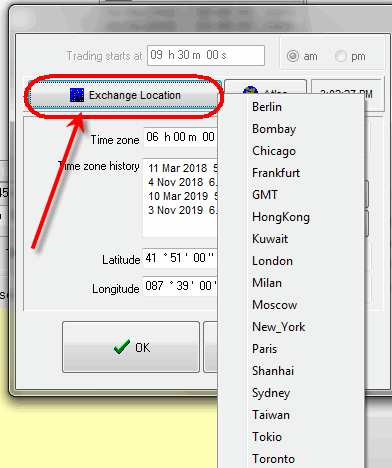
Keywords
Exchange location, trading hours, parallax, diurnal cycle, cycle period, Turbo cycles module, wavelet diagram, Phenomena module, planetary hours, planetary lines
Introduction
While working with intraday charts, please keep in mind that technologies applied to daily charts may not work with intraday charts. There is also one important issue regarding intraday models: there is no model that works for ever. The stock market constantly changes, in spite of all rules and regulations there, it is still a game, and the game with rules that are changing constantly. Accordingly you must be prepared to revise your models on a regular basis. It is the same reason that prompts to revise trading robots used by big players. This is the reason why we revise Timing Solution software. You have to accept this fact and not waste your time searching for traders' Holy Grail.
Exchange location
The first thing to take care of is the exchange location for your financial instrument. This is especially important for models that are based on astronomical phenomena. Consider this, as an example: let say we do a research on how the Moon position in respect to the horizon affects the stock market behavior within a day; we should remember that the Moon position depends strongly on the place on the Earth where we are observing the Moon. In other words, the astronomical phenomenon observed in New York City may not take place in London. Though we do not do actual observations of the planets and the Moon nowadays, it is still assumed that we do - if we want to use astronomical phenomena correctly.
With Timing Solution, you can define the exchange location here, while downloading the price
history:

In this class you will find special notices when the models that are discussed depend on the exchange location.
Trading hours
After downloading the price history, usually you get this notification message:
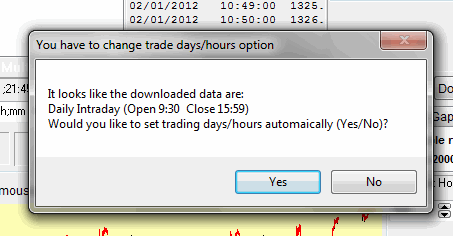
In most cases the program automatically specifies the trading hours that are used for downloaded price history. You can also set these hours manually clicking this button:
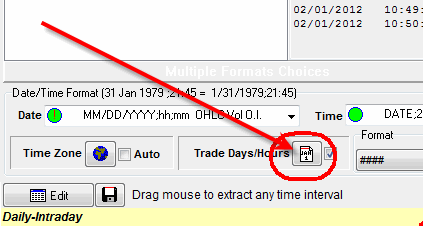
Mark the difference between daily intraday data (i.e. taken without overnight data) and weekly intraday data (i.e. with overnight data).
Parallax or no parallax
This is a factor that should be taken into account for intraday trading.
Imagine now two friends. One of them lives in New York, while the other lives in Moscow. Both are looking at the Moon at the same time and measure accurately the Moon's position. They will be surprised as the position of the Moon will be different. This difference can reach 1 degree in longitude. It is called "parallax". For intraday trading models this difference can be critical, so you may set the parallax for astronomical calculations through "Options" in "Astronomy" tab:
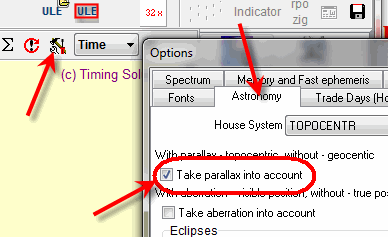
But the question still persists: "should we employ parallax or not?". We have not exact answer on this question, and tend to think that should (i.e. set parallax option ON). But we recommend to try both variants.
Model #1: Diurnal cycle (not exchange dependable)
If Annual cycle is the most important cycle for daily data, the diurnal cycle should be considered as
an important cycle for intraday data. This
cycle is not so strong as Annual cycle for daily data, though it should be
considered in any case. To calculate a diurnal cycle, simply set
ON for Natural cycles option; this cycle will be displayed in the Main
screen:
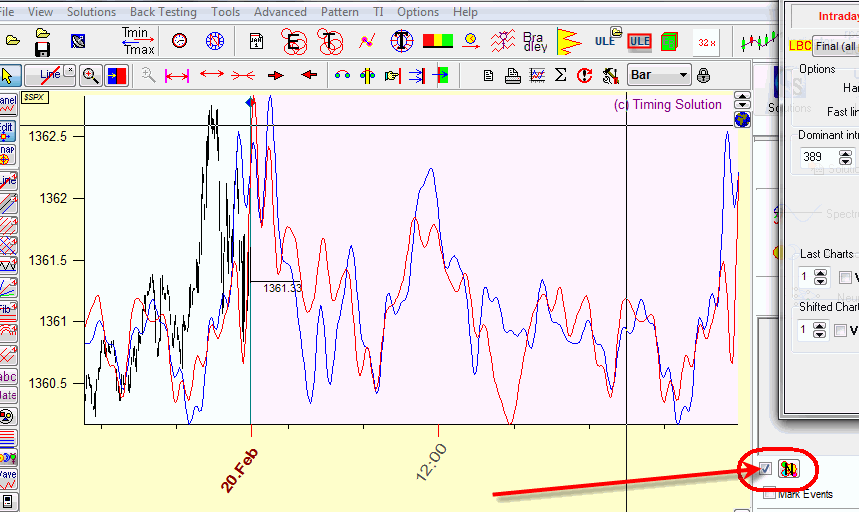
Model #2: Turbo Cycles model (not exchange dependable)
This model provides the projection line based on dominant cycles. The program scans all cycles and extracts the most important ones. See the diagram below; the peaks there correspond to the most important cycles:
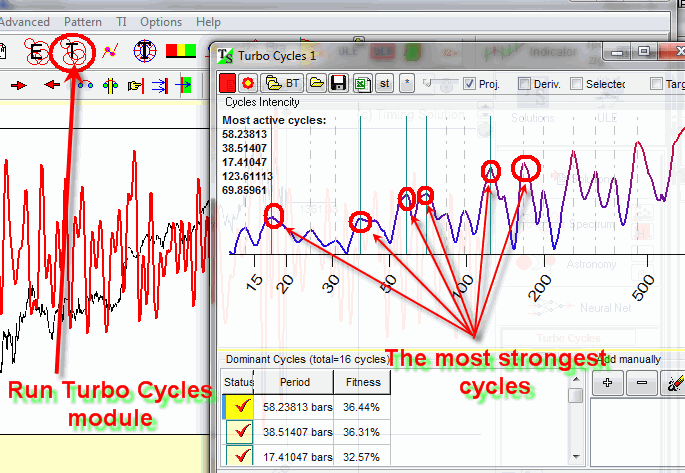
The higher and narrower peak means that the corresponding cycle is stronger than others. Keep in mind that the cyclical structure is constantly changing, the new cycles appear while the old ones disappear.
The projection line presents the superposition of the most influential cycles. This is how this projection line looks:
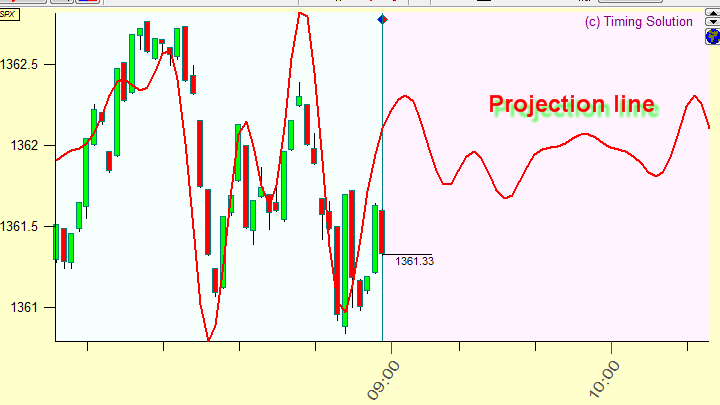
While the new price history comes in real time, the program
automatically recalculates the cycles and makes corrections to the projection line.
However, you should remember that this model has its restrictions (as any other
cycle
based model). Such models work when the stock market is in cyclical mode, not
a trend
mode. I do not know any formal workable criteria to specify a cyclical
mode. So the non-formal visual criteria are recommended, here they are:
Here is an example:
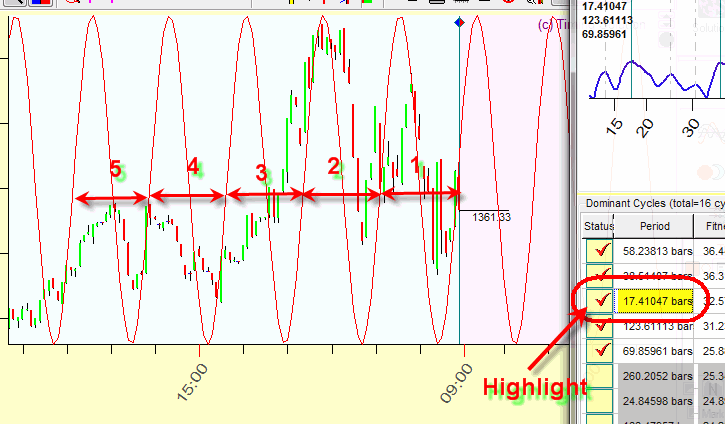
The cycle is active within five full periods, this is less than seven full periods.
We recommend to verify all calculated cycles in respect to the cyclical mode of the market. In order to do that, highlight these cycles one by one and view them in the Main screen:
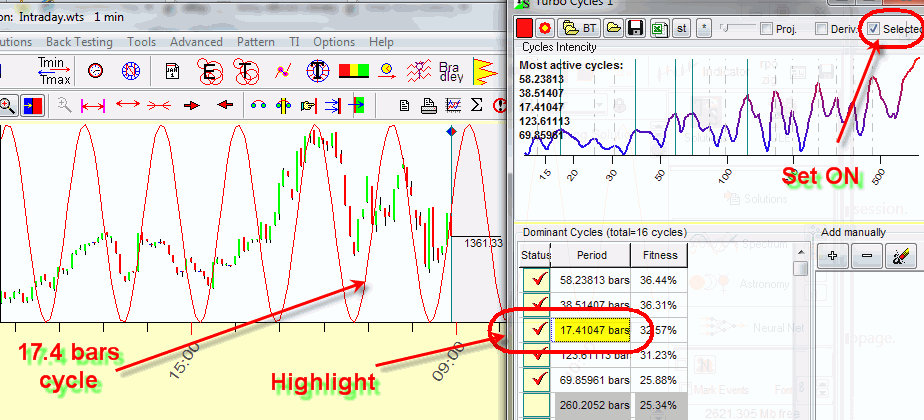
In this example you can see here how 17 bars cycle works.
Recently a new model has been developed. We can calculate cyclic models using wavelet math; we do that in Cycle Hunter module. So far this is a very promising, though still experimental module; many users apply it for their trading and share the results that helps to improve it..
In wavelet module you can see the birth of new cycles. You can see them on the wavelet diagram as bright regions. So, dragging the mouse cursor over this region you immediately get the projection line for this cycle together with the price chart, like this:
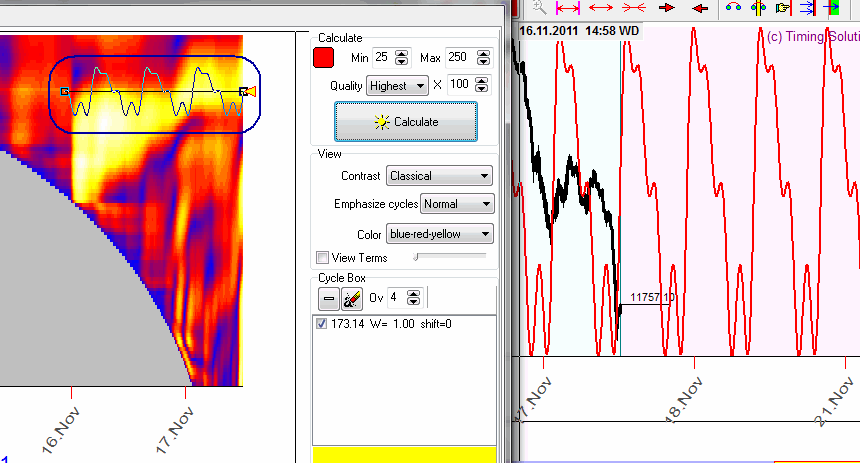
This module has been developed especially for intraday, so it works very fast in real time.
Going into depth: More about this approach see here: http://www.timingsolution.com/TI/7/index.htm
Model #3: Phenomena model (exchange dependable)
The Moon makes one full cycle around the Earth in 27 days, accordingly
it travels through Zodiac one degree in two hours approximately. We recommend to pay attention
at the moments when the Moon enters new degrees, this event happens approximately
once in two hours. To calculate these moments, follow these steps:
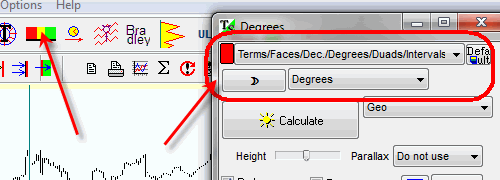
This is how this diagram looks together with the price chart:
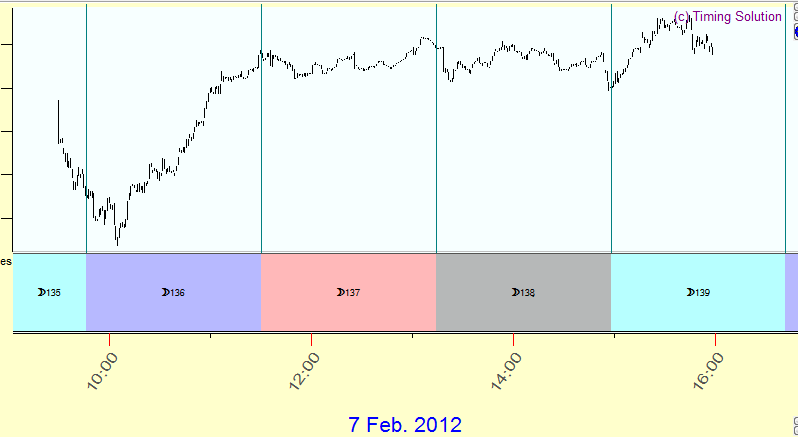
You can see here the moments when the Moon enters a new (next) degree of Zodiac, these moments often coincide with important stock market events.
There is one very important issue regarding this model: these periods depend on
the fact whether we use the parallax in our astronomical calculations or we do not use
it. We recommend to try both possibilities varying this parameter in
Phenomena module:
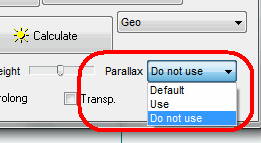
Also some users use planetary hours, here they are:

These hours are calculated the same way as they were calculated in the ancient time. The major moments there are sunrises and sunsets, so these hours are not equal (day and night hours), and they change within a year.
We recommend to display the phenomena model together with the price chart and pay attention to the moments of change (when the Moon passes some degree or a planetary hour changes).
Models #4: Turning points analyzer (not exchange dependable)
If you have enough price history available, you may apply Turning Points analyzer module. To run Turning Points analyzer, click this button:
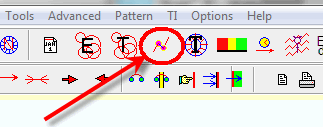
You will get this diagram:
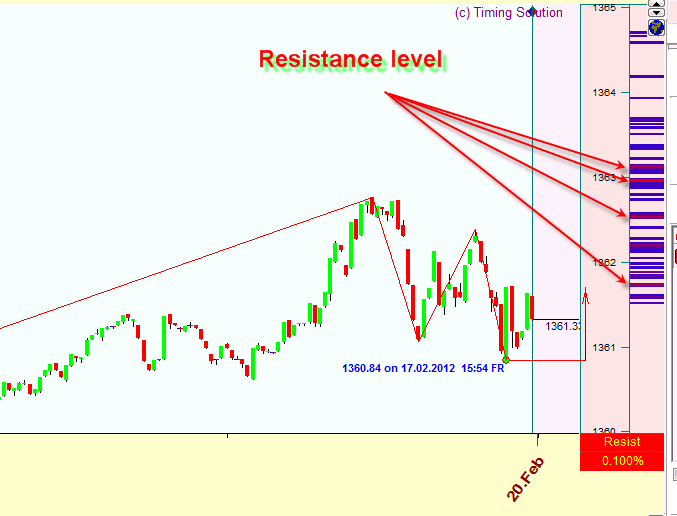
The red stripes there correspond to the most probable support and resistance levels. These levels are calculated using statistics for turning points. So you need to watch the amount of turning points that is used for the calculation. The amount of turning points is displayed in the left corner:

The minimum of turning points should be 50, better 100 or more. You can also vary the amount of turning points dragging the scroll bar. This way you change the zigzag critical swing that is used to calculate the turning points.
Charting tools
This is the most used part of Timing Solution software. However, it is very difficult to specify what charting tools are more/less important. We recommend to read first this article regarding these techniques: http://www.timingsolution.com/TS/Study/ts_charting_tools/index.htm Try Advanced and Astro Based charting tools. You can easily find Andrew's pitchfork, Fibonacci ellipses practically in any charting software, while Advanced and Astro Based charting tools are presented in Timing Solution only.
Also, we recommend planetary equidistant lines charting tool. This is the example:
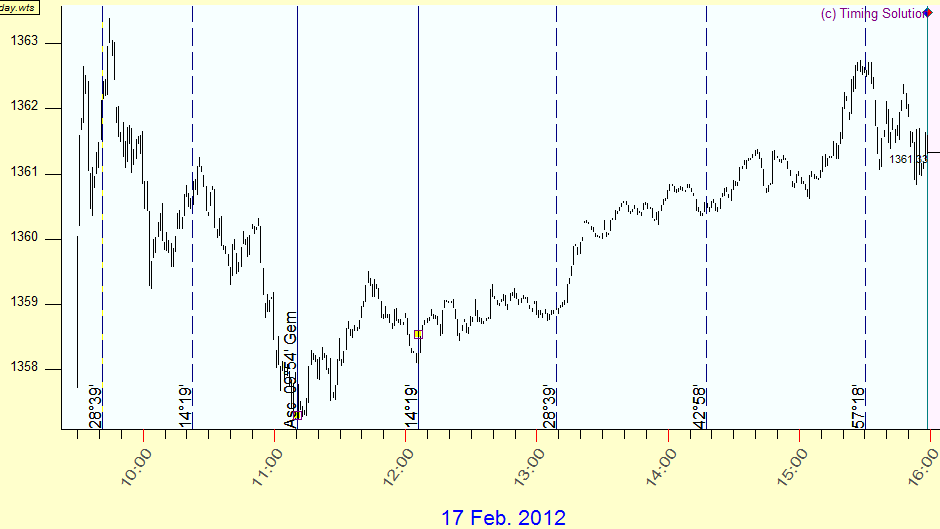
These lines correspond to the positions of Ascendant traveling 14 degrees 19 minutes; those who are not familiar with astrology may take it as a movement of the horizon plane over the Equator. We recommend to use these planetary combinations:
the Moon, Moon phases and Asc:
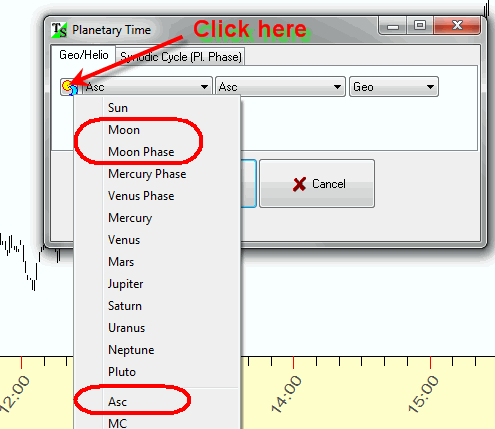
Planetary lines
Many users use Planetary Lines module. This module is developed to reveal the support / resistance levels using planetary positions. Though all calculations are done correctly here, we must warn you regarding this module, as we have not find yet any formal way to verify it. However, it is a very popular module among TS users.
This is how planetary lines look:
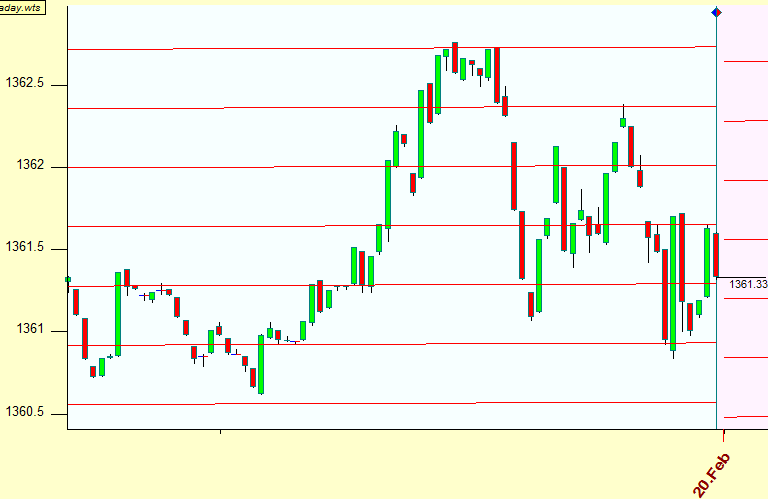
We recommend to vary scale, harmonics and planetary combinations:
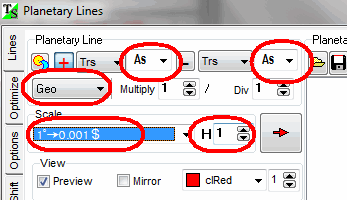
The most important question here is what planets should be used. Based on the experience of Timing Solution users, it is worth to use the most important planets of the day and the Moon.
February 2012, December 2012
Sergey Tarassov.